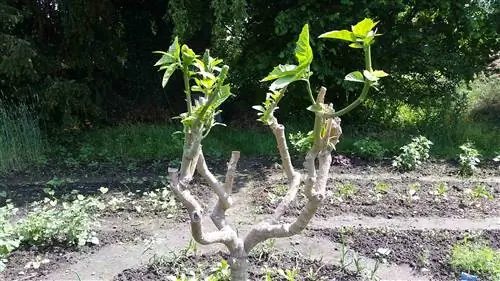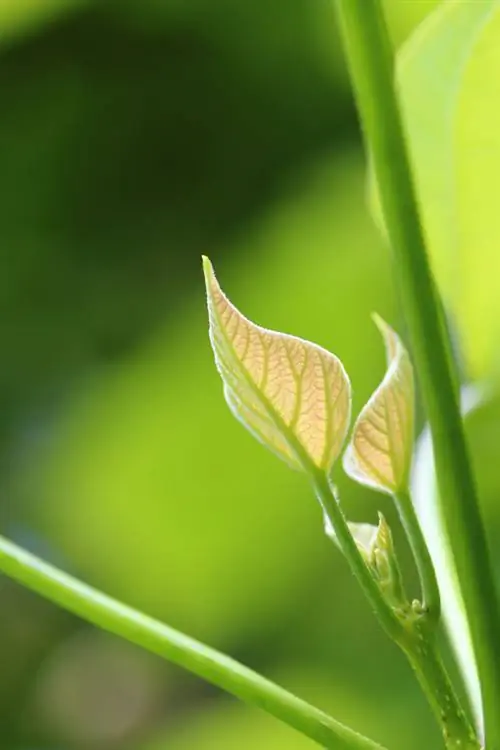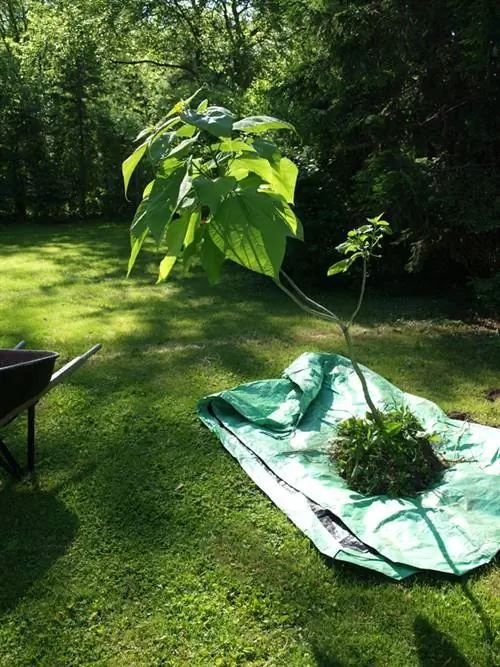- Author admin [email protected].
- Public 2023-12-16 16:46.
- Last modified 2025-06-01 06:02.
A trumpet tree develops its monumental presence without any annual pruning. If the crown becomes too dense, bulky or sprawling, thinning and shaping will solve the problem. Read this tutorial about when and how to properly prune a catalpa as a house tree.
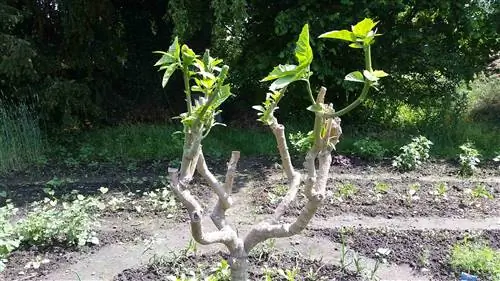
When and how should you prune a trumpet tree?
A trumpet tree should be cut in late winter to thin out the crown, maintain the shape and avoid space problems. Depending on the type of tree, thinning, topiary or derivation cuts may be necessary to ensure optimal growth and appearance.
Best time is in winter
The best time to prune a trumpet tree is inlate winter. At other times, the most beautiful attributes of your house tree fall victim to the scissors or they collide with the regulations of the Federal Nature Conservation Act. The following overview summarizes all the arguments for a winter cutting time:
- Leaf-free winter time allows a perfect overview of the crown
- Decorative fruit decoration made from long pods is preserved for a long time
- Free view of planted flower buds
- Gentle for the tree in dormancy
- No harmful impact on nesting birds
Alternatively, trim a trumpet tree after the flowering period in August. At this time the tree has not yet put on the flower buds for next year. If pruning care is limited tothis year's growth, pruning is permitted within the summergrace period.
Tip
Never trim your trees at temperatures below -5 degrees Celsius. Further exclusion criteria when choosing a date are summer heat and drought as well as rain. Extreme weather conditions of all kinds torpedo the cutting results and even lead to total failure.
Instructions for thinning cut
A trumpet tree develops its representative stature without any pruning. Occasional thinning is still an advantage so that the crown is flooded with light and thrives with dense foliage. The image below illustrates how a thinned trumpet tree appears before and after. How to make the perfect thinning cut:
- Thin out the crown every 5 to 6 years in winter
- Cutting dead wood on a branch
- Remove branches growing in the wrong direction
- Cut out the weaker one from parallel shoots without a long stump
- Cut or tear off shoots from the trunk or tree disc
Do you have doubts about whether a shoot has died or not? Then carry out a simple vitality test. Use your thumbnail or the tip of a knife to scrape off a piece of bark. If juicy, light or green tissue appears, life is pulsating in the shoot and it will continue to grow. Dark, dry tissue, on the other hand, signals that growth has stopped at this point and the branch should be thinned out.
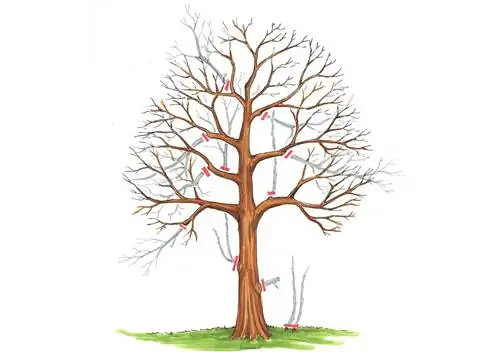
Every 5 to 6 years the trumpet tree benefits from a thinning cut. Cut off dead wood on Astring. Branches that grow into the inside of the crown, cross each other or are unfavorably positioned are removed. Tear off stem shoots and wildlings from the tree disc.
Excursus
Expert preparation - avoid security risks
In order for the gardener and the trumpet tree to survive the pruning process safely, it is important to make the right preparation. The basic equipment includes a sturdy ladder, work gloves and safety glasses. Loppers are available for cutting branches up to 4 cm in diameter, either with a bypass or anvil mechanism. You can handle thick branches with a Japanese saw. For gardeners who are not afraid of heights, we recommend Combisystem pruning shears, which cut at heights of up to 5 meters without having to climb the ladder. Scissor blades and saw blades should be sharp, sparkling clean and disinfected. If you expect a whole mountain of clippings, a garden shredder will take care of the disposal.
Topiary cuts regulate space problems
The expansive crown growth of trumpet trees is often underestimated. With a growth height of 10 to 15 meters, the crown extends over an impressive diameter of 8 to 12 meters. This can cause space problems even in large gardens. The most common reason for a topiary cut on the common trumpet tree is to professionally reduce the size of the crown. After a thorough thinning cut, proceed as follows:
- Best time is in January/February on a mild, overcast day
- Shorten excessively long scaffolding branches by a third or half
- Make the cut 5 to 10 mm above an opposite pair of buds
- Massively branched, overhanging shoots slim down onto a young side shoot
After each cut, take a few steps back to plan what to do next. You can avoid larger holes in the crown by giving preference to a derivation cut rather than a simple shortening. If you find yourself forced to remove a thick branch, please proceed in stages. Saw the branch from below about 40 centimeters away from the trunk. Pull out the saw and move the next cut point 10 centimeters to the right or left. Now saw until the branch breaks off. Last but not least, saw off the stump on Astring.
Background
Derivation perfects topiary
Please don't be tempted to cut off a massive crown. The devastating result is a trumpet tree with the appearance of a willow tree. Thecrown reductioncan be done more discreetly if you are familiar with the technique of thederivation cut To do this, take a look at an overly long scaffold shoot. Look for a lower positioned, slanting outward side shoot. Place the saw or scissors exactly where both shoots fork. Ideally you should cut a few millimeters in the old wood. The previous side shoot rises in the branch hierarchy and immediately takes over the local leadership position.
Cutting the ball trumpet tree
A ball trumpet tree gets to know pruning shears more often than its big brother. This applies at least to an older specimen when the spherical crown loses its harmonious shape. The figure below illustrates how a skilful shape and thinning cut can be achieved at intervals of 2 to 3 years. How to cut Catalpa bignonioides 'Nana' correctly:
- The best time to prune is in late winter
- Cut back all main branches by up to two thirds
- Important: leave at least a 15 to 20 cm long stump standing
- Choose interfaces within a short distance of a sleeping eye
Wound treatment of larger cut surfaces has proven to be disadvantageous. Instead of completely sealing cuts with tree wax, just coat the edges of the wound. This place contains valuable cambium wood, which is responsible for the tree's own wound healing and should be protected from frost.
Moderate recut
A radical crown cut reduces the amount of pruning required in the following years by up to two thirds. If you give your spherical trumpet tree another topiary cut after a few years, the scope will be limited to the branches that have sprouted since then. Cut branches located at the previous interfaces back to the base. This incision leaves a slightly larger crown framework that retains its harmonious spherical shape.
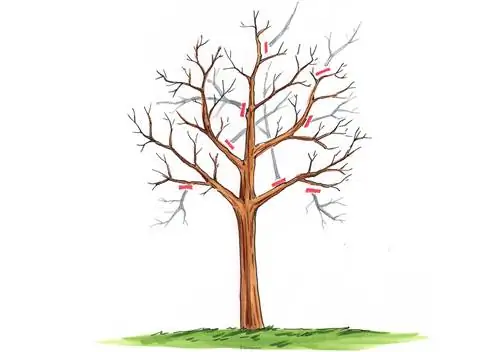
Tighten the ball crown every 2 to 3 years. Shorten sprawling branches by up to two thirds. As long as a 15 to 20 centimeter long stump with sleeping eyes remains, growth continues unabated.
Frequently asked questions
Is a trumpet tree poisonous?
Experts classify the trumpet tree as slightly toxic. The tree species is not listed on the official list of poisonous plants from the Federal Ministry for the Environment, Nature Conservation and Nuclear Safety. According to an overall study by the GIZ (Poison Information Center North), there is a minimal risk of poisoning if plant parts are swallowed in large quantities. Relevant to gardeners are quinoid ingredients in wood, which can trigger allergic reactions upon direct skin contact.
I purchased my new trumpet tree with 3 thin trunks that have grown to 3 meters. How do I get a crown to form?
If you want to train a trumpet tree as a single-shoot trunk, select the sturdiest shoot and equip it with a support rod. Cut the remaining thin stems at ground level. If the shoot tip is 4 to 6 buds above the desired crown base, cut off the tip bud. Lateral branches then sprout, which form leading branches to the crown.
Winter protection is recommended for a freshly planted trumpet tree. Which tree areas need to be protected? Which material is suitable?
Primarily the root area and trunk should be protected from winter weather conditions. In autumn, cover the tree disc with a thick layer of mulch made from leaves and brushwood or bark mulch. Wrap the trunk with fleece or jute ribbons.
Our trumpet tree has been in the bed for a year and has grown quickly. However, many branches are weak and constantly break. What to do?
Catalpa bignonioides is easily susceptible to breakage when young. You can counteract this shortcoming by regular thinning and shaping. Remove dead and damaged shoots regularly in the first few years. By cutting back the crown by a third in late winter, you encourage the growth of young, he althy and resilient branches. Every cut creates a sap in the fast-growing wood, which has a beneficial effect on a compact, dense and evenly branched crown.
The 3 most common cutting mistakes
Cautious gardeners follow the motto when it comes to pruning care: a recognized danger is a danger averted. The following table draws attention to the three most common cutting errors that cause damage and provides tips for prevention:
| Cutting errors | malicious image | Prevention |
|---|---|---|
| never cut | sprawling crown, branch tips hanging like trails when old | thin every 5 to 6 years and cut into shape |
| oversized crown radically cut | misshapen growth | Discharge excessively long scaffold shoots |
| cut in autumn | no fruit decorations in winter | blend in January or February |

Tip
Strengthening winter hardiness is a big issue in trumpet tree care. To ensure that your house tree is well prepared for severe frost, it receives a potassium-rich fertilizer in the fall. In the natural garden, comfrey manure fulfills this task. Alternatively, administer Thomaskali, Patentkali or Kalimagnesia at the end of August/beginning of September at the latest.

